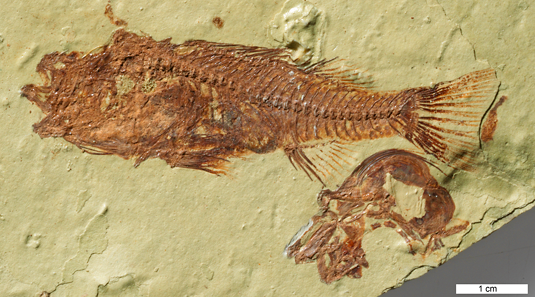
The question of what conditions were like in the Rift Valley of East Africa 12 million years ago (Mya) has been the subject of intense debate. Now new research just published by a team led by LMU paleontologist Professor Bettina Reichenbacher strongly suggest that extensive grassland habitats were already established in the region by that time. The study’s findings appear in the Geological Magazine, one of the most respected journals in the Earth Sciences.
In 2013 Bettina Reichenbacher and her colleagues discovered a Middle to Late Miocene fossil Lagerstätte in Kenya’s Tugen Hills, which harbors one of the few diverse and well preserved collections of fish fossils yet found anywhere in the world. “Almost all of these specimens belong to the cichlid family (Cichlidae), which still represents a major component of the fauna of East Africa’s Great Lakes today, and they provide a unique glimpse of the evolutionary history of this group,” says Reichenbacher. Her graduate students Melanie Altner and Stefanie Penk have devoted the past several months to the analysis of a fraction of the material so far recovered from the Tugen Hills. Meanwhile, her former Master’s student Cornelia Rasmussen (now at the University of Utah in Salt Lake City) has been studying the sedimentology of the site and her LMU colleague Dr. Jerome Prieto has analyzed the mammalian fossils found in the locality. Dr. Olaf Lenz of the Institute for Applied Geosciences at the Technical University (TU) in Darmstadt brought his expertise to bear on the pollen samples found in the sediments, while Dennis Brüsch (TU Darmstadt) investigated the mineralogy of the clay samples recovered.
Taken together, the results of these analyses provide a rich source of data that will enliven the debate relating to the nature of the climate and the range of environments available in this part of Africa in the Late and Middle Miocene (11-16 Mya). The issue is of considerable interest, because the Rift Valley in Kenya has yielded a rich trove of hominid fossils over the past 80 years or so. Knowledge relating to the climate, ecology and habitats of the region therefore provides insight into the conditions under which the lineage that gave rise to Homo sapiens evolved.
Shaped by catastrophic events
The data derived from the paleontological investigations are incompatible with several previous assumptions. The analyses reveal that some of the fish species identified in the area lived in bodies of water that were quite deep, and were located in semiarid settings. These findings imply that, during the period concerned, tropical woodlands were in decline, and were being replaced by grasslands that were poor in tree species. “The vegetation may have looked rather like that of the grasslands set with acacia trees that are found in modern Somalia,” says Reichenbacher. Based on the pollen found in the sediments, the researchers deduce that the climate was getting drier.
The fish fossils from the area that had been studied up to now all belonged to a single size class, but the LMU team recovered a trove of specimens ranging in size from 1.2 to 15 cm in length. This wide size variation among fossils recovered from the same sedimentary level suggests that all the individuals died over a very short space of time. This in turn implies the occurrence of a sudden and catastrophic event, which wiped out whole populations. This interpretation is supported by the presence of a layer of ash at the same level. “It is very likely that mass die-offs of fish are linked to outbursts of volcanic activity during this period,” says Bettina Reichenbacher.
The impact of tectonic activity
A detailed study of the sediments in which the fish fossils were discovered indicated that, during the period between 9 and 12 Mya, several instances of abrupt change in water levels must have occurred in the lakes and rivers around the Tugen Hills. Most previous studies had assumed that fluctuations in the local climate were responsible for the variations in water levels, but Bettina Reichenbacher maintains that “abrupt changes in the nature of the sediment, in the mineral composition of the parent rock, such as we have discovered, cannot be attributed to fluctuations in climate. We therefore believe that they were caused by tectonic activity.”
Among the fossil material excavated, Reichenbacher’s team has already identified several new species of cichlid. In further studies, they hope to clarify the relationships between the fossil specimens and the cichlids found in the Rift Valley today. “We hope to learn from the evolutionary history of the cichlids whether or not a single drainage system existed in the area in the Later Miocene. The alternative possibility is that the modern drainage networks, whose course is determined by the mountains that define the Rift Valley and which are now characterized by uniquely diversified fish faunas, may have already formed by that time,” Reichenbacher explains.
Reference:
CORNELIA RASMUSSEN et al. Middle–late Miocene palaeoenvironments, palynological data and a fossil fish Lagerstätte from the Central Kenya Rift (East Africa), Geological Magazine (2015). DOI: 10.1017/S0016756815000849
Note: The above post is reprinted from materials provided by Ludwig Maximilian University of Munich.










